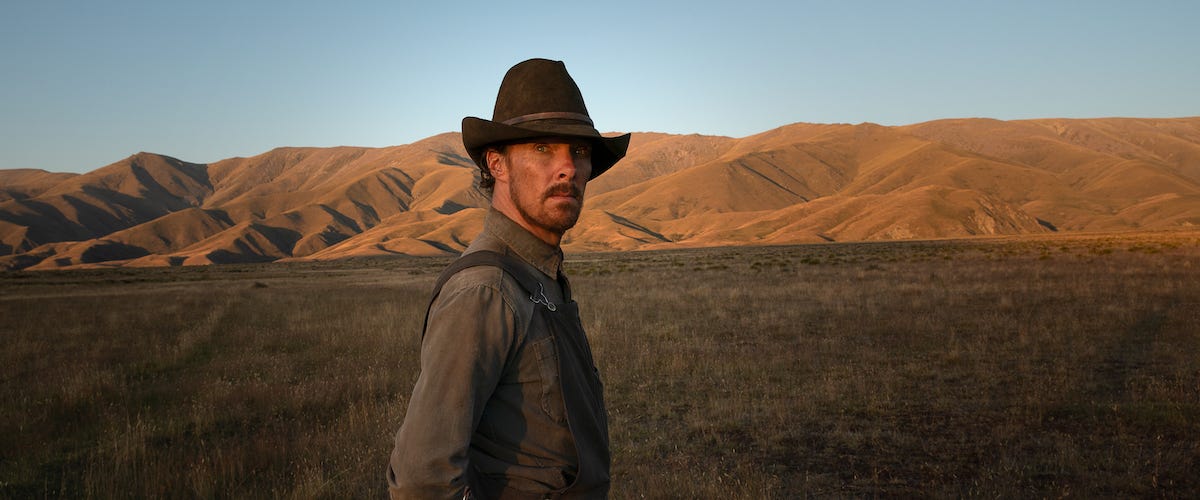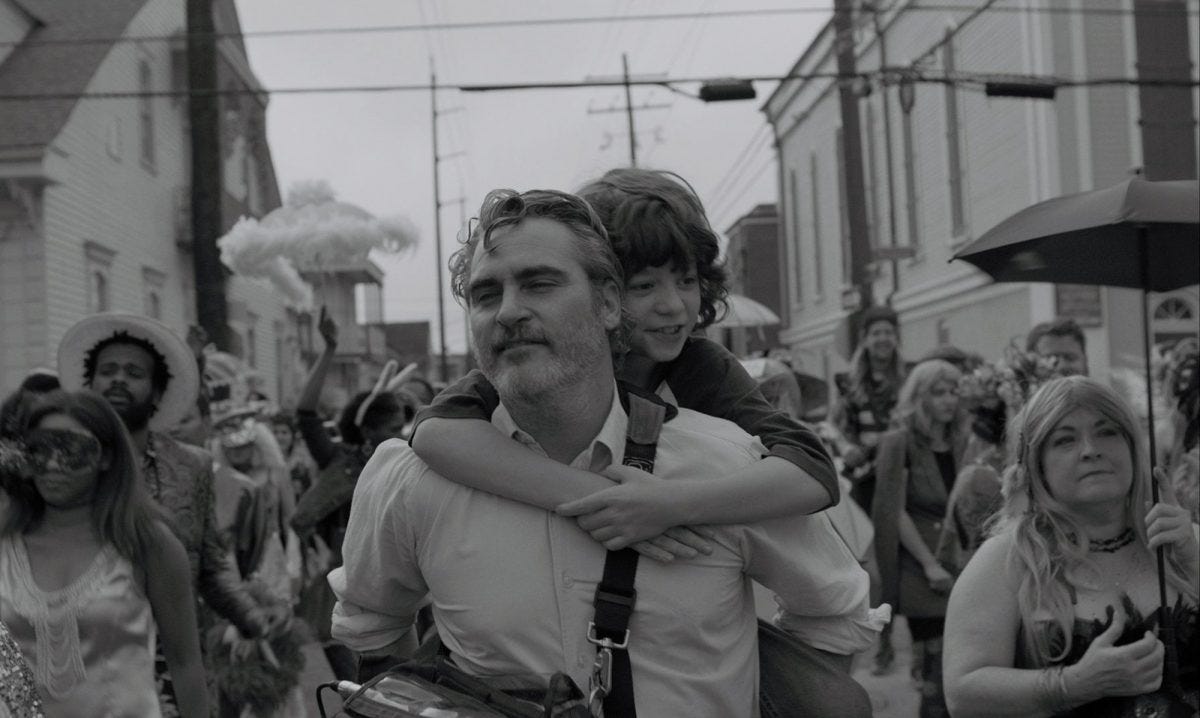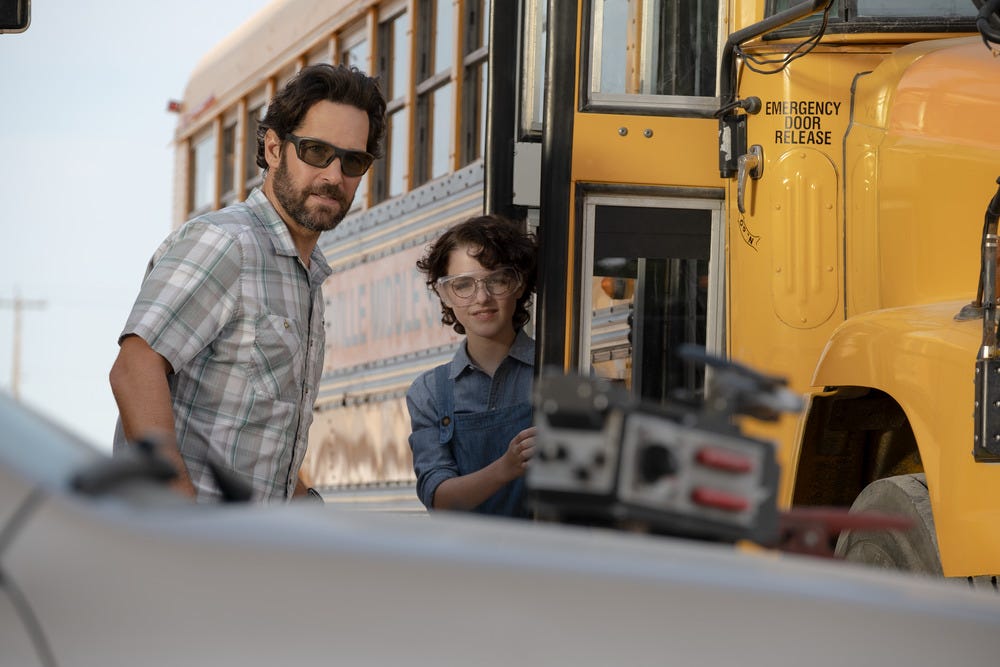In Review: 'The Power of the Dog,' 'C'mon, C'mon,' 'Ghostbusters: Afterlife'
In this week's reviews, Jane Campion evokes the tortured masculinity of 'The Piano,' Mike Mills hits the road, and Jason Reitman returns to his father's wheezing franchise.
The Power of the Dog
Dir. Jane Campion
125 min.
The game is played on the field, not on paper. What’s true in sports is also true in movies, which might help explain why Jane Campion’s The Power of the Dog, a film whose conceit makes it sound like a graceless battering-ram, plays with such dazzling verve on the screen. Then again, it helps to remember that the Campion work it most resembles, her 1993 Palme D’Or-winning sensation The Piano, underlines the repressive social mores of the mid-19th century by literally making its heroine mute. And that Campion played the hell out of that one on the muddy field of remote New Zealand.
Working from Thomas Savage’s 1967 novel, Campion has made a film that is, unmistakably, about toxic masculinity. It’s centered on a macho rancher in 1920s Montana whose alpha-dog impulse to dominate and intimidate wreaks needless havoc, terrorizing everyone around him while deepening his own feelings of bruised alienation. And when the source of this impulse is revealed, it’s every bit as thuddingly obvious as you might expect, a crude skeleton key to unlock the mysteries of his psyche. I’d guess that many people reading this review right now can guess what that revelation is without having seen a single frame.
But again, the game is not played on paper. A film that initially seems too schematic gains in complexity as the characters add dimension and Campion uncorks one gripping setpiece after another. Even the monster in question, played in an unlikely but chillingly persuasive turn by Benedict Cumberbatch, isn’t the simple brute he appears to be, though it takes time for the fullness of his sociopathy to bloom. Our first glimpse of his Phil Burbank is at a small cafe in town, where he’s assembled his ranch-hands for a dinner that quickly turns into a bullying session. Phil sits imperiously at the head of the table, hurling insults at his brother George (Jesse Plemons), whom he calls “fatso” with an impunity that suggests a power imbalance. George relies on Phil to keep their business operating and improve his social standing, and Phil abuses him for it.
Phil also takes notice of an elegant bouquet of paper flowers arranged in a small vase on the table, and is disgusted to learn that his reedy male server, in every respect the opposite of a grizzled Montanan, is responsible for making them. So he burns them for sport. This small act of terror is merely the opening volley of a long campaign against the server’s widowed mother, Rose (Kirsten Dunst), who’s cooking in the back and has the mixed fortune of falling for George, who eventually marries her. When George brings Rose and her son, Peter (Kodi Smit-McPhee), back to the family estate, the enhancement in luxury and social status is diminished by the twin pressures of living up to the family name and withstanding Phil’s hostility. Naturally, she takes to the bottle.
The Reveal is a reader-supported newsletter dedicated to bringing you great essays, reviews and conversation about movies (and a little TV). While both free and paid subscriptions are available, please consider a paid subscription to support our long-term sustainability.
The Power of the Dog expands considerably from there, particularly once Phil decides to give the intellectual Peter some hard lessons in ranching and learns that there’s more to this peculiar fellow than he’d anticipated. There are different kinds of men, yes, but also different ways of expressing power—another theme from The Piano, in which the heroine works hard to leverage her independence. As these characters clash against the brilliant blue skies of Montana—or New Zealand doubling half-convincingly as Montana, anyway—they reveal hidden aspects of themselves, some surprising even to them. Phil would not seem to have much in common with Sam Neill’s character in The Piano, a man who presented himself as more civilized than the rustics around him, but both seethe with the same kind of self-hating, self-defeating rage when under duress. The point in both films is that toxic masculinity isn’t just a wellspring of terror—it also rots at the source.
Campion allows the most important scenes to unfold with exquisite agony, like Peter adding a macabre postscript to Phil’s lecture on how to work a rabbit trap, or Phil disrupting Rose’s futile attempts to play Strauss’ “Radetzky Match” on piano by working his banjo. (Surely the homage to Deliverance, another key work about masculinity, was intentional on Campion’s part.) As long a shadow as Phil—and Cumberbatch’s performance—casts over the film, the eternally youthful Dunst plays Rose as somehow older than her years, brought low by a marriage that’s imprisoned her and her son. And there’s an uncanny quality to Smit-McPhee’s presence here that’s as unsettling in its quiet, clinical fastidiousness as any of Phil’s boorish ravings. It doesn’t take long before The Power of the Dog, to paraphrase Roger Ebert, is less interesting for what it’s about than how it’s about it. — Scott Tobias
The Power of the Dog is in select theaters this week and will come to Netflix on December 1st.
C’mon C’mon
Director: Mike Mills
108 min.
A movie with a premise like C’mon C’mon's is supposed to follow a familiar path. The latest from Mike Mills (Beginners, 20th Century Women) stars Joaquin Phoenix as Johnny, a single, childless, New York-based public radio journalist whose latest project finds him traveling from city to city interviewing children about their hopes, dreams, fears, and disappointments and what they expect the world will be like when they grow up. Though semi-estranged from his sister Viv (Gaby Hoffman), Johnny’s pressed into service caring for his nephew Jesse (Woody Norman) when Viv has to leave Los Angeles to care for her bipolar husband Paul (Scoot McNairy), who’s left the family to live on his own in another city. What begins as a short-term assignment gets extended, however, when Paul’s crisis worsens, leaving Johnny in charge of Jesse for the foreseeable future.
Cute kid. Oscar winner. What do you need, a road map? But Mills seems to have thrown his out, if he ever had one. C’mon C’mon makes some familiar narrative stops, but it rarely lingers at them long. Moments that seem like major plot developments—a scene in which a distracted Johnny loses Jesse in the streets of New York, for instance—come and go, mostly serving to further Jesse and Johnny’s relationship as they get to know one another. Mills is content to let the film drift in stretches, to let it mirror the confusion of uncle and nephew as they try to figure out what’s going on and what to do next. Any other approach might feel like just another cute kid movie.
That doesn’t mean the film itself is aimless. As with his previous features, Mills guides with a steady hand even as he creates a relaxed atmosphere, even while dealing head on with the difficulties of raising a kid. Especially a weird kid: Jesse is odd, and not in a cutesy movie way. He asks uncomfortable questions and has habits and fixations that trouble both Viv and Johnny, like an insistence on role-playing the part of a lonely orphan who shows up at night and asks to sleep in Jesse’s bed. (Viv, in this fictional scenario, is grieving the death of her child.) But he’s also odd in a way that’s recognizable to anyone who’s spent much time with kids. They’re little eccentrics with surprising takes on how the world works, little sense of what’s appropriate, and emotions that ping-pong all over the place.
They’re also perceptive and insightful, as Johnny had already gleaned from his interviews even before his extended time caring for Jesse. Over the course of C’mon C’mon, Johnny’s forced to close the gap between journalistic objectivity and lived experience by dealing with a kid for longer than the length of an interview and living with the ambitions and anxiety he’s used to recording and filing away. (These are taken from unscripted conversations between Phoenix and children in each of the four cities in which Mills shot the film.). He’s forced to close other gaps as well, or at least attempt to, including the schism that’s opened up between him and Viv, and the space he’s created between himself and the rest of the world.
Mills has cited Wim Wenders’s Alice in the Cities as inspiration for C’mon C’mon’s road movie structure. That inspiration presumably extends to the decision to shoot, working with cinematographer Robbie Ryan (Marriage Story, The Favourite), in striking black and white, a choice that lends a sense of gravity and timelessness to everyday moments like bedtime stories and walks through the park. Mills knows that this is what we do, what we’ve always done, as we hurtle into the unknown future with kids by our side, doing our best to point them in the right direction even when we don’t know the way. —Keith Phipps
C’mon, C’mon is in select theaters.
Ghostbusters: Afterlife
Dir: Jason Reitman
125 min.
Pointless nostalgia reaches terminal velocity with this latest attempt at reviving Ghostbusters, a beloved 1984 movie that made a potent combination of ace comedy stars and cool special effects. That formula has proven difficult to recreate over the years. Ghostbusters II couldn’t do it, despite bringing back everyone involved in the original. Paul Feig’s Ghostbusters couldn’t do it, despite a first-rate cast of its own. (And let's not even talk about original director Ivan Reitman’s own attempts at similar combinations of comedy and effects, Evolution and My Super Ex-Girlfriend.) Directed by Jason Reitman (son of Ivan) and co-written by Reitman and Gil Kenan, Ghostbusters: Afterlife at least deserves a smidgen of credit for attempting something new—or it would if that something new wasn’t somebody else’s something old.
Ghostbusters: Afterlife doesn’t try to replicate the style and attitude of the 1984 original. Instead, it replicates the style and attitude of a film Steven Spielberg might have made in the same era, repurposing material from the original for a story of kids on bikes stumbling upon danger and unexplainable mystery in one of the most mundane corners of America. Here that’s Summerville, Oklahoma, where Callie Spengler (Carrie Coon), daughter of Egon Spengler, the character played by Harold Ramis in the original film and its sequel, moves after inheriting a dilapidated farmhouse where her father relocated long ago for reasons no one around him understood. Callie drags two bummed-our children with her: Trevor (Finn Wolfhard), a gawky teen who quickly falls for rollerskating carhop Lucky (Celeste O’Connor), because time apparently has stopped in this part of Oklahoma; and Phoebe (McKenna Grace), an awkward science enthusiast who comes to realize that something might be up with the old abandoned mine down the road. Also on hand: Chad, a disenchanted summer school teacher whose own interest in strange phenomena (and Callie) draws him into Phoebe’s investigation, and a kid named Podcast (Logan Kim), so called because he has a podcast.
For much of its running time, Ghostbusters: Afterlife dutifully pays homage to (that’s the polite phrase) the spirit of Spielberg and Spielberg-adjacent films made by Amblin Entertainment in the ’80s. It’s not great, but Rudd and Coon are charming, the kids are winning enough, and Reitman provides sure, if blandly anonymous, guidance behind the camera. But the film’s innate hollowness becomes increasingly apparent as the constant references to the original stop feeling nostalgic and start feeling cynical. It’s essentially, as ScreenCrush’s Matt Singer observed, the Rick Dalton Points meme in movie form. Ghostbuster: Afterlife’s constant callbacks eventually reveal it less as an act of homage than of cannibalization. Why create new bad guys when Gozer and the Stay-Puft Marshmallow Man are sitting right there? (The film’s one significant contribution is Muncher, essentially a metal-eating variation on Slimer voiced by Josh Gad, if that counts as originality). All the while, the score offers what sound like John Williams discards between snippets of the Elmer Bernstein theme from the original.
Then it gets worse. Much worse. The details of the ghastly finale probably count as a spoiler, even if Columbia hasn’t exactly been keeping it a secret that original cast members return. So let’s leave it unspoiled beyond saying there’s a Grand Canyon-sized gulf between the film’s apparently sincere desire to pay tribute to Ramis and the ghoulish onscreen results. Then again, maybe it fits since the whole film ultimately plays like a misguided attempt at reanimation. The subtitle is Afterlife. It should read Undead. —Keith Phipps
Ghostbusters: Afterlife is in theaters everywhere.











Back in mid-90s, me was somewhere where there was bowl of candy hearts. They were chalky, tasteless candy with messages stamped on them like "Be Mine" or "Love You." Me picked one out of bowl and it said, "Web Site."
Naming character "Podcast" have very similar energy. "Hey, we need to sound hip! What are kids into?"
And that probably nicest thing me will have to say about Ghostbuster movie at end of day.
Anyway, these other two look great. Me especially happy to see Jane Campion come roaring back after spending 2010s in wilderness. (First season of Top of Lake was terrific, but two short season of that show was only thing she directed between 2009 and now.)
I think I found a factual error in your Ghostbusters: Afterlife review. You say that Muncher is voiced by Josh Gad. My understanding is that he is voiced by noted movie expert, founder of the Victorville Film Archive and star of Ant-Man Gregg Turkington, as mentioned on last week's episode of On Cinema At The Cinema (https://www.heinetwork.tv/episode/red-notice-ghostbusters-afterlife/).